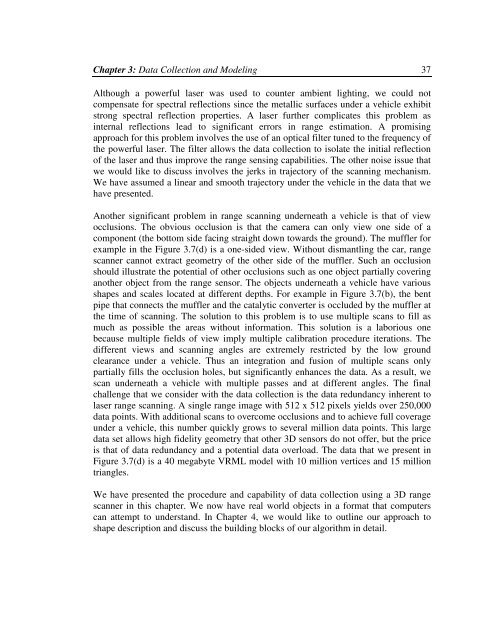To the Graduate Council: I am submitting herewith a thesis written by ...
To the Graduate Council: I am submitting herewith a thesis written by ...
To the Graduate Council: I am submitting herewith a thesis written by ...
Create successful ePaper yourself
Turn your PDF publications into a flip-book with our unique Google optimized e-Paper software.
Chapter 3: Data Collection and Modeling 37Although a powerful laser was used to counter <strong>am</strong>bient lighting, we could notcompensate for spectral reflections since <strong>the</strong> metallic surfaces under a vehicle exhibitstrong spectral reflection properties. A laser fur<strong>the</strong>r complicates this problem asinternal reflections lead to significant errors in range estimation. A promisingapproach for this problem involves <strong>the</strong> use of an optical filter tuned to <strong>the</strong> frequency of<strong>the</strong> powerful laser. The filter allows <strong>the</strong> data collection to isolate <strong>the</strong> initial reflectionof <strong>the</strong> laser and thus improve <strong>the</strong> range sensing capabilities. The o<strong>the</strong>r noise issue thatwe would like to discuss involves <strong>the</strong> jerks in trajectory of <strong>the</strong> scanning mechanism.We have assumed a linear and smooth trajectory under <strong>the</strong> vehicle in <strong>the</strong> data that wehave presented.Ano<strong>the</strong>r significant problem in range scanning underneath a vehicle is that of viewocclusions. The obvious occlusion is that <strong>the</strong> c<strong>am</strong>era can only view one side of acomponent (<strong>the</strong> bottom side facing straight down towards <strong>the</strong> ground). The muffler forex<strong>am</strong>ple in <strong>the</strong> Figure 3.7(d) is a one-sided view. Without dismantling <strong>the</strong> car, rangescanner cannot extract geometry of <strong>the</strong> o<strong>the</strong>r side of <strong>the</strong> muffler. Such an occlusionshould illustrate <strong>the</strong> potential of o<strong>the</strong>r occlusions such as one object partially coveringano<strong>the</strong>r object from <strong>the</strong> range sensor. The objects underneath a vehicle have variousshapes and scales located at different depths. For ex<strong>am</strong>ple in Figure 3.7(b), <strong>the</strong> bentpipe that connects <strong>the</strong> muffler and <strong>the</strong> catalytic converter is occluded <strong>by</strong> <strong>the</strong> muffler at<strong>the</strong> time of scanning. The solution to this problem is to use multiple scans to fill asmuch as possible <strong>the</strong> areas without information. This solution is a laborious onebecause multiple fields of view imply multiple calibration procedure iterations. Thedifferent views and scanning angles are extremely restricted <strong>by</strong> <strong>the</strong> low groundclearance under a vehicle. Thus an integration and fusion of multiple scans onlypartially fills <strong>the</strong> occlusion holes, but significantly enhances <strong>the</strong> data. As a result, wescan underneath a vehicle with multiple passes and at different angles. The finalchallenge that we consider with <strong>the</strong> data collection is <strong>the</strong> data redundancy inherent tolaser range scanning. A single range image with 512 x 512 pixels yields over 250,000data points. With additional scans to overcome occlusions and to achieve full coverageunder a vehicle, this number quickly grows to several million data points. This largedata set allows high fidelity geometry that o<strong>the</strong>r 3D sensors do not offer, but <strong>the</strong> priceis that of data redundancy and a potential data overload. The data that we present inFigure 3.7(d) is a 40 mega<strong>by</strong>te VRML model with 10 million vertices and 15 milliontriangles.We have presented <strong>the</strong> procedure and capability of data collection using a 3D rangescanner in this chapter. We now have real world objects in a format that computerscan attempt to understand. In Chapter 4, we would like to outline our approach toshape description and discuss <strong>the</strong> building blocks of our algorithm in detail.
















